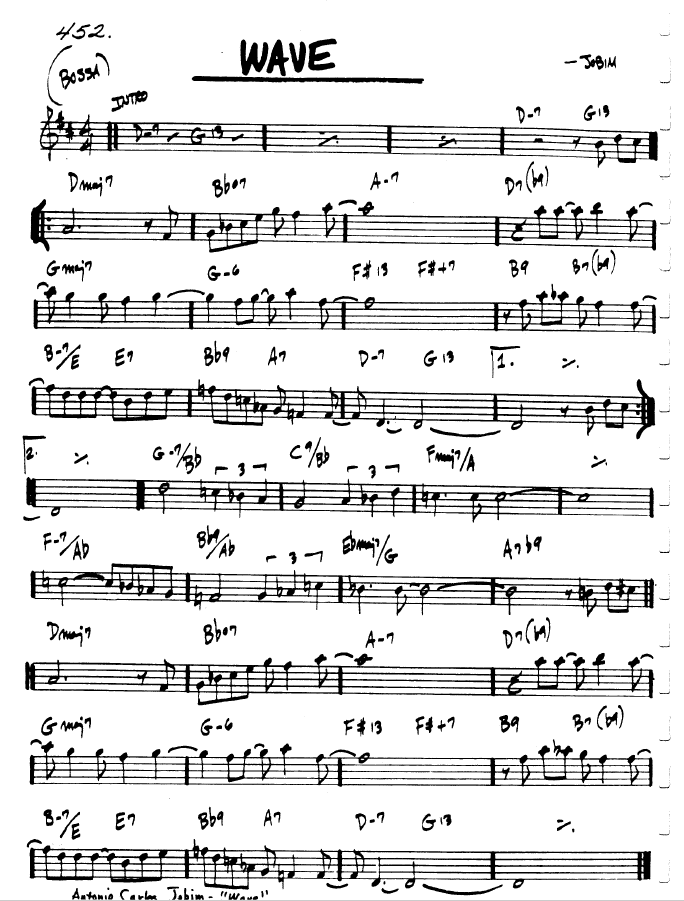Arranger's Hell - brought to you by Antonio Jobim
-
The vocalist in our jazz band loves this piece and so we're playing it at a jazz festival in a couple of weeks. The changes are (pick one) murderous/a wonderful challenge to solo over. Unfortunately I've not moved beyond murdering a wonderful challenge. I decided to notate a solo to get a few ideas cemented.
Check the changes - no chord is repeated until the end of the A section. I kept a simple base line as I just want some chordy noises to work with, but boy! Jobim must've been sadistic dude

-
tj, I want to help (if I can) but I just don't find a question in your post. What is it you would like us to comment on?
-
@Kehaulani thanks - I wrote that post at the end of a laborious of entering chords on the bass line of this song. For most tunes, this is a quick process because chord patterns repeat and after initially entering a pattern once, it can be cut and pasted when repeated. The repeated patterns also make life a little easier when playing an improv solo. Not so with Mr Jobim. His tunes lead one down the garden path and if due attention is not paid to the changes, I find myself clashing violently (or unpleasantly) with sound made by the band. Hence the work on the chart that I'm doing.
Interesting that you've replied - I recall you commenting in the past on TM (forgive me if I'm mis-paraphrasing) that trumpet players tend to be not as observant as sax players of chord changes when soloing.
My question is: what techniques do improvisors use when working over changes such as those written by Jobim? My stand-by method of, know what key, know the form of the song, the melody and a glance at the changes, then just think about the line I want to play is breaking down here. -
This is the C-Instrument version of Wave:

First of all, play the opening DOWN the octive if you are playing ANY of the head, as this is the Tenor Sax voicing. But it sounds to me that you are really backing up around the vocalist. Now that you have the chords written out, playing around them is the task at hand. The real HARD part is interjecting your lines AROUND the vocalist. This is an art form and changes second to second in real time, so writing out an improve line may not work. My recommendation is to just go to a real book in advance of the gig and practice playing around it OR even better find a vocalist singing this on YouTube and rehears to that recording with these changes in front of you.Hope this helps and is the idea you are looking for.
-
I read the question differently, so my answer only refers to the chords of three measures and how to negotiate the notes. This explanation may be well known to you, so if the answer doesn't apply to you, sorry. It may be of some value to others.
When a sequence gets to complex, a way of getting around it is not to get complex or do too much micro-analyzing but to use this simple approach. Know the first chord and just change the note or notes that are new in the following chord.
How I might approach this example might be to write out the first scale and write each successive scale below each other.
Then look at the scales and identify the notes that are different from one scale to the other. Then, as yo play the subsequent notes, don't think horizontally, that is the construction of each chord, but think vertically substituting the notes as you progress.This is really hard for me to write clearly, so I hope one can understand the concept.
An aside. When I was on tour with a particular band, we often would hit the motel lounge after a gig, catching the house band's last set. We always knew what they were made of by listening to how they handled the bridge to Girl From Ipanema, LOL.
-
Let me offer an example: Here is a trumpet player (Till Bronner) backing up a female vocalist on another Jobim song, "Once I Loved". He keeps the background simple in answers to the words or faint backing up the lines she is singing, but sparingly so. Hope this provides some idea of what you may be able to offer with a vocalist in front.
Notice also that on Till's solo, it is basically the chart with different phrasing and yes a few creative notes added as well.
-
@Kehaulani said in Arranger's Hell - brought to you by Antonio Jobim:
I read the question differently, so my answer only refers to the chords of three measures and how to negotiate the notes.
To me, it appears tj is working though the entire song but uses the measures identified as an anchor: "The changes are (pick one) murderous/a wonderful challenge to solo over." To me, this sounds like inclusive of the entire chart.
I also get the impression from tj also saying, "Check the changes - no chord is repeated until the end of the A section..." which he then references ONLY the repeat. So again, I believe tj is desiring to find an improv style to the complete piece behind the entire vocal part.
TJ... is this your intent?
-
@Dr-GO
Well, this is answered by just waiting for tj's next installment. Maybe zoning in a little more on what he needs. -
@Kehaulani @Dr-GO, thanks for your help so far.
Hope I haven't caused confusion by not framing my question right at the start. I play a solo over either AA or full form AABA - depending on how timing is going in the set.
We are playing in the same key as the above chart. To date I've been playing the first A section pretty much "as writ". To Gary's point above, it's not an ideal register to play a beautiful rich, smooth, relaxed solo.
Ideally, I want to outline the head in the first A section, but do this in a lower register where I can be a little more expressive. This is not a huge deal, but when I try to play an improv solo in the second A (and sections, the changes catch me out. My tiny mind has problems hearing chord changes which are sometimes counter-intuitive and making up a melody line - all in real-time. This second A/B is what I'm working on with the chart. I'm hoping that writing out a few notes/licks will help cement the structure in my head so I can just close my eyes and get back to having fun playing the solo.
sections, the changes catch me out. My tiny mind has problems hearing chord changes which are sometimes counter-intuitive and making up a melody line - all in real-time. This second A/B is what I'm working on with the chart. I'm hoping that writing out a few notes/licks will help cement the structure in my head so I can just close my eyes and get back to having fun playing the solo.@Kehaulani - your comment about bands playing the bridge in Ipanema is exactly what I'm trying to avoid. Thanks for providing another voice in my head that I have to push out of the way when playing

-
tj - do you know the harmonic structure of the tune? Where the major and minor cadences are and what leads up to them? Momentary modulations and chord substitutions? Someone like Chet Baker could intuit this stuff. But for we mere mortals, a good knowledge of the harmonic direction helps a great deal. How goes that?
BTW, the playing range of your improvised solo doesn't have to be controlled by the melody range whatsoever. You can choose to play anywhere you want; total freedom.
-
@tjcombo said in Arranger's Hell - brought to you by Antonio Jobim:
Ideally, I want to outline the head in the first A section, but do this in a lower register where I can be a little more expressive. This is not a huge deal, but when I try to play an improv solo in the second A (and
 sections, the changes catch me out.
sections, the changes catch me out.tj, don't be so rough on yourself. Listen again to Tills solo in the recording I posted above. His solo rides so close to the written head, with a bit of weaving of some now notes and time, but remains more with the head then with improv. Give that technique a try. It will give your sound confidence and take the stress out of the performance.
-
@Dr-GO and Kehaulani, thanks for your help on this one.
The Till Bronner solo is beautiful (not a bebop line in sight or sound :-)). It's so simple, yet masterfully done.We had our final rehearsal yesterday before next weekend's gig. I wrote out a few melodic ideas and some guide-tones on a chart and all went smoothly (and most of all musically :-)). If I get time this week will go through a similar exercise on some of the other pieces. It's certainly worth doing in tunes where the tonal centre constantly changes.
-
Great, I'll bet the confidence feels good.
-
@tjcombo said in Arranger's Hell - brought to you by Antonio Jobim:
We had our final rehearsal yesterday before next weekend's gig.
So tjcombo... how did the gig go?
-
@Dr-GO thanks for asking Gary. The gig was great - fantastic room, good crowd who enthusiastically responded. I still disappeared up a musical rat-hole on the solo, but I was probably the only one who noticed. I'm sure that you've confronted the dangers of over-thinking a piece of improv.